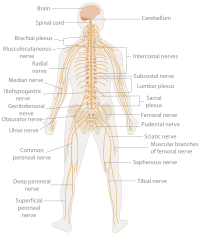
Photo from wikipedia
BACKGROUND Diagnostic performance based on X-ray breast imaging is subject to breast density. Although digital breast tomosynthesis (DBT) is reported to outperform conventional mammography in denser breasts, mass detection and… Click to show full abstract
BACKGROUND Diagnostic performance based on X-ray breast imaging is subject to breast density. Although digital breast tomosynthesis (DBT) is reported to outperform conventional mammography in denser breasts, mass detection and malignancy characterization are often considered challenging yet. PURPOSE As an improved diagnostic solution to the dense breast cases, we propose a dual-energy DBT imaging technique that enables breast compositional imaging at comparable scanning time and patient dose compared to the conventional single-energy DBT. METHODS The proposed dual-energy DBT acquires projection data by alternating two different energy spectra. Then, we synthesize unmeasured projection data using a deep neural network that exploits the measured projection data and adjacent projection data obtained under the other X-ray energy spectrum. For material decomposition, we estimate partial path lengths of an X-ray through water, lipid, and protein from the measured and the synthesized projection data with the object thickness information. After material decomposition in the projection domain, we reconstruct material-selective DBT images. The deep neural network is trained with the numerical breast phantoms. A pork meat phantom is scanned with a prototype dual-energy DBT system to demonstrate the feasibility of the proposed imaging method. RESULTS The developed deep neural network successfully synthesized missing projections. Material-selective images reconstructed from the synthesized data present comparable compositional contrast of the cancerous masses compared with those from the fully measured data. CONCLUSIONS The proposed dual-energy DBT scheme is expected to substantially contribute to enhancing mass malignancy detection accuracy particularly in dense breasts. This article is protected by copyright. All rights reserved.
Journal Title: Medical physics
Year Published: 2022
Link to full text (if available)
Share on Social Media: Sign Up to like & get
recommendations!